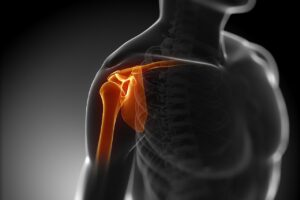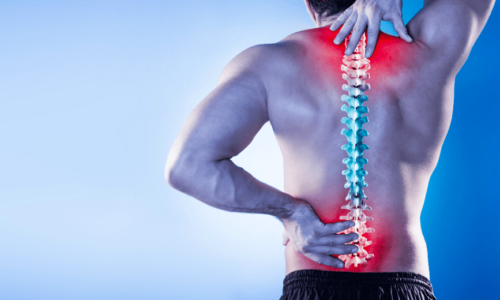What causes my shoulder pain? |

The National Ambulatory Medical Care Survey found that over the course of a year up to 50% of the general population will experience shoulder pain, with half of them consulting a physician. In most cases, this discomfort is related to trauma, although there are many other causes for shoulder pain.
The shoulder is made up of three bones: the upper arm bone (humerus), the shoulder blade (scapula), and the collarbone (clavicle). The head of the humerus fits into a curved socket, called the glenoid, which is part of the shoulder blade. A group of muscles and tendons, known collectively as the rotator cuff, keep the arm bone centered in the shoulder socket and allow for movement in many different directions. This mobility, however, comes at a price, since the shoulder joint is less stable than most joints in the body. This increases its susceptibility to a number of problems.
Overuse Conditions Affecting the Shoulder. Overuse conditions, also known repetitive strain injury (RSI), are conditions characterized by chronic inflammation brought on by excessive use of a particular body part. Overuse conditions in adults are most often occupationally-related, whereas in younger individuals they are often a result of a sports-related repetitive activity. Some of the most common overuse conditions affecting the shoulder are:
- Bursitis— A bursa is a fluid-filled sac that acts as a cushion between muscles, tendons, and joints. There are a number of bursae around the shoulder joint. The one most commonly affected in the shoulder is located between the rotator cuff and a portion of the shoulder blade known as the acromion. Excessive use of the shoulder, such as repeated raising and lowering of the arm, can cause this bursa to become inflamed, a condition known as subacromial bursitis. Subacromial bursitis can have an impact on many activities of daily living as well as affecting job performance with certain occupations.
- Tendinitis—A tendon is specialized type of connective tissue that connects muscles to bone. Tendonitis, or inflammation of the tendon, can develop suddenly from overuse (acute tendonitis) or more gradually, due to aging and “wear and tear” (chronic tendonitis). Examples of activities that can cause shoulder tendonitis include playing sports that require the arm to be moved over the head repeatedly, as in tennis, and working with the arm overhead for prolonged periods, as when painting. The most commonly affected tendons in the shoulder are the rotator cuff tendons and the tendon that connects to the biceps muscle.
- Impingement—This common shoulder condition is named for its mechanical cause, rather than for an affected structure. In shoulder impingement, a portion of the shoulder blade known as the acromion rubs against the underlying soft tissues (bursa, tendons, muscles) when the arm if lifted overhead. This repeated rubbing or “impingement” causes these tissues to become inflamed with the development of bursitis or tendonitis. Symptoms of impingement are similar to that of shoulder bursitis/tendonitis and include shoulder pain with lifting, reaching behind the back, or with overhead movements. Commonly, impingement-related pain will be felt on the outside (lateral aspect) of the shoulder or become particularly noticeable at night.
Treatment of Overuse Conditions of the Shoulder: Almost always, initial treatment of overuse conditions of the shoulder is nonsurgical. Resolution of symptoms, however, may take several weeks or months with very gradual improvement and return to function. The first step is to modify activity so that painful motions, such as overhead lifting, are avoided. Typically, a course of non-steroidal anti-inflammatory medicines (ibuprofen, Aleve, others) are given to help reduce pain and swelling. Once the pain has begun to resolve, physical therapy, either self-directed or formal, is employed to help restore strength and regain any range of motion that had been lost. This program usually involves some combination of stretching, strengthening and range of motion exercises. In some instances, an injection of a corticosteroid into the region of the inflamed bursa or tendon may also be helpful if the measures mentioned above are not completely successful.
If you have any more questions just Ask Hanna, our health advisors are here to help.
Image: ©Shutterstock / SciePro








